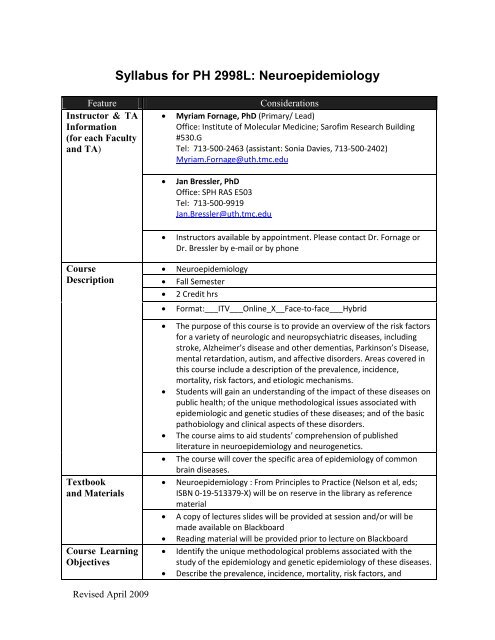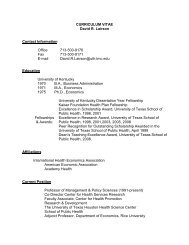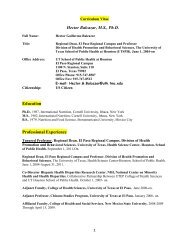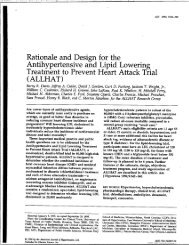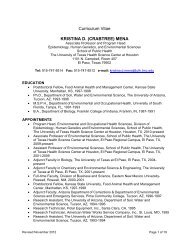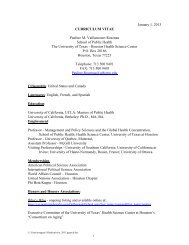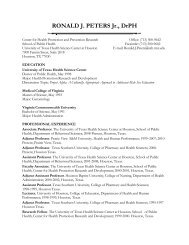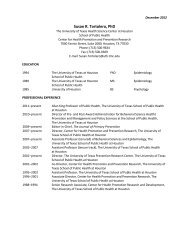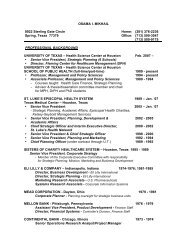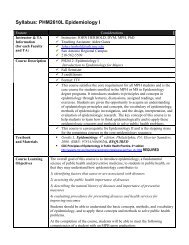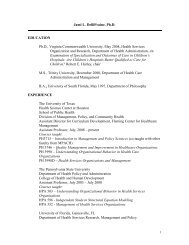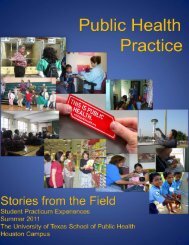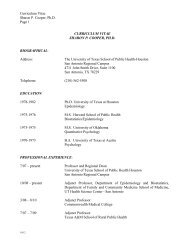Syllabus for PH 2998L - University of Texas School of Public Health
Syllabus for PH 2998L - University of Texas School of Public Health
Syllabus for PH 2998L - University of Texas School of Public Health
You also want an ePaper? Increase the reach of your titles
YUMPU automatically turns print PDFs into web optimized ePapers that Google loves.
Revised April 2009<br />
<strong>Syllabus</strong> <strong>for</strong> <strong>PH</strong> <strong>2998L</strong>: Neuroepidemiology<br />
Feature Considerations<br />
Instructor & TA<br />
In<strong>for</strong>mation<br />
(<strong>for</strong> each Faculty<br />
and TA)<br />
Course<br />
Description<br />
Textbook<br />
and Materials<br />
Course Learning<br />
Objectives<br />
• Myriam Fornage, PhD (Primary/ Lead)<br />
Office: Institute <strong>of</strong> Molecular Medicine; Sar<strong>of</strong>im Research Building<br />
#530.G<br />
Tel: 713-500-2463 (assistant: Sonia Davies, 713-500-2402)<br />
Myriam.Fornage@uth.tmc.edu<br />
• Jan Bressler, PhD<br />
Office: S<strong>PH</strong> RAS E503<br />
Tel: 713-500-9919<br />
Jan.Bressler@uth.tmc.edu<br />
• Instructors available by appointment. Please contact Dr. Fornage or<br />
Dr. Bressler by e-mail or by phone<br />
• Neuroepidemiology<br />
• Fall Semester<br />
• 2 Credit hrs<br />
• Format:___ITV___Online_X__Face-to-face___Hybrid<br />
• The purpose <strong>of</strong> this course is to provide an overview <strong>of</strong> the risk factors<br />
<strong>for</strong> a variety <strong>of</strong> neurologic and neuropsychiatric diseases, including<br />
stroke, Alzheimer’s disease and other dementias, Parkinson’s Disease,<br />
mental retardation, autism, and affective disorders. Areas covered in<br />
this course include a description <strong>of</strong> the prevalence, incidence,<br />
mortality, risk factors, and etiologic mechanisms.<br />
• Students will gain an understanding <strong>of</strong> the impact <strong>of</strong> these diseases on<br />
public health; <strong>of</strong> the unique methodological issues associated with<br />
epidemiologic and genetic studies <strong>of</strong> these diseases; and <strong>of</strong> the basic<br />
pathobiology and clinical aspects <strong>of</strong> these disorders.<br />
• The course aims to aid students’ comprehension <strong>of</strong> published<br />
literature in neuroepidemiology and neurogenetics.<br />
• The course will cover the specific area <strong>of</strong> epidemiology <strong>of</strong> common<br />
brain diseases.<br />
• Neuroepidemiology : From Principles to Practice (Nelson et al, eds;<br />
ISBN 0-19-513379-X) will be on reserve in the library as reference<br />
material<br />
• A copy <strong>of</strong> lectures slides will be provided at session and/or will be<br />
made available on Blackboard<br />
• Reading material will be provided prior to lecture on Blackboard<br />
• Identify the unique methodological problems associated with the<br />
study <strong>of</strong> the epidemiology and genetic epidemiology <strong>of</strong> these diseases.<br />
• Describe the prevalence, incidence, mortality, risk factors, and
Learning<br />
Activities<br />
Student<br />
Assessment<br />
And Grading<br />
Criteria<br />
Prerequisites<br />
and/or<br />
Technical<br />
Requirements<br />
Policies<br />
and Procedures<br />
Revised April 2009<br />
etiologic mechanisms.<br />
• Describe the impact <strong>of</strong> neurologic diseases on public health<br />
• Describe the methodologies to identify genes influencing neurological<br />
diseases<br />
• Describe basic pathophysiology and clinical aspects (symptomatology,<br />
diagnosis, and treatment) <strong>of</strong> major neurologic diseases<br />
• Student will learn to critically appraise published literature in<br />
neuroepidemiology and neurogenetics by presenting selected papers<br />
<strong>for</strong> issues related to study rationale/ hypothesis, design, analysis, and<br />
interpretation<br />
• Letter grade (A,B,C,F or I) based on class attendance (20%); a student<br />
presentation (40%) and final in class examination (40%). Final grades<br />
will be assigned as follow: A(≥90); B(≥80); C(≥70); F(
Course Calendar<br />
Revised April 2009<br />
• Incomplete Grades:<br />
o Consideration <strong>for</strong> incomplete grades will be made on a caseby-case<br />
basis. Students should contact the instructor directly.<br />
Incomplete grades will not be granted because <strong>of</strong> poor<br />
per<strong>for</strong>mance.<br />
• Students are expected to attend class regularly<br />
• Academic Dishonesty<br />
o Current school policy applies. See<br />
http://www.sph.uth.tmc.edu/uploadedfiles/catalog.pdf<br />
o Evidence <strong>of</strong> academic dishonesty will result in grade F<br />
o It is assumed that, <strong>for</strong> group activities, all students will<br />
contribute to the assignment and will not take credit <strong>for</strong> work<br />
accomplished by others.<br />
• E-mail Procedures and online etiquette<br />
o Include course number in subject line <strong>for</strong> all e-mail<br />
correspondence<br />
• Separate Document


